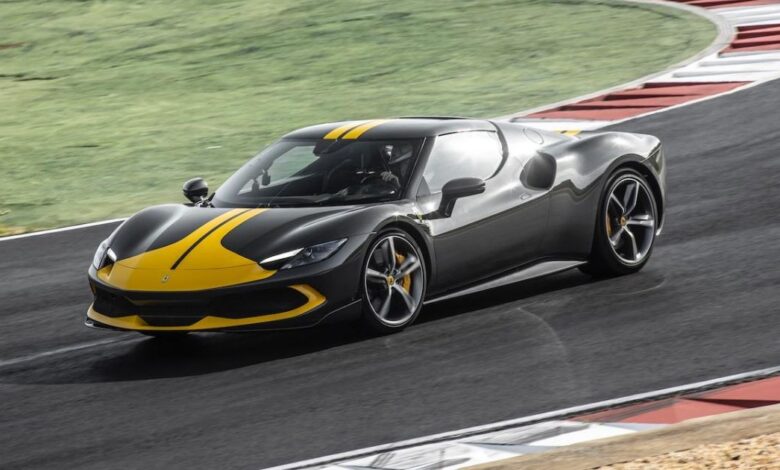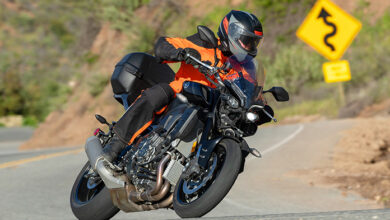2022 Ferrari 296 GTB review

After 350km of flat-out driving on some of Andalusia’s finest B-roads in the wet, and a track session at Monteblanco circuit, I’m quite sure the all-new Ferrari 296 GTB is the finest road car to come from the Prancing Horse stable in the last decade.
Here’s the kicker: it’s not a V12, or even a V8. Instead, it’s a plug-in hybrid combining a new 3.0-litre (2992cc) twin-turbo V6, a rear-mounted electric motor, and a high-voltage battery to make it one of the quickest series-produced road cars Ferrari has ever made, regardless of engine capacity or displacement.
How quick, you ask? Of all the road cars that have lapped Ferrari’s famed Fiorano test track, the 296 GTB sits fifth on a leaderboard which includes the F12tdf, Enzo, 488 Pista, and 812 Superfast. The only models to have officially clocked a faster lap time than its 1.21.00 result are the SF90 Stradale (1.19.00), SF90 Spider (1.19.50), LaFerrari (1.19.70), and 812 Competizione (1.20.00).
Ferrari’s first ever V6 road car is mighty fast, and why wouldn’t it be? Ferrari knows about V6 turbos, after its 1982 126 C2 Formula 1 car became the first turbocharged car to win the F1 Constructor’s Championship.
A V6 turbo hybrid architecture has been used on all Formula 1 cars since 2014 and that know-how and technology has surely been put to good use in the 296 GTB.
The 296 GTB is a clean-sheet design, and becomes the first Ferrari-badged V6 road car. Remember, the Dino never wore a Ferrari badge.
Don’t think of this car as replacement for the F8 Tributo. It’s an all-new model with an all-new powertrain, Ferrari says, which worked tirelessly to develop huge outputs and one of the best sounds you’ll ever hear… regardless of configuration or displacement.
So good is the noise Ferrari’s powertrain engineers nicknamed the engine “piccolo V12” during development. Better still, the note is piped into the cabin just behind the driver through two different sources for double the effect.
In the metal the 296 GTB is stunning to look at, blending shapely aesthetic form and advanced aerodynamics with design cues reimagined from legendary Ferraris like the LM250, Dino 206, and 330 P3.
While it may not have been mentioned in the press material, there’s also unmistakable design inspiration from the recent limited-edition Daytona SP3; a car that clearly takes some cues from those iconic Ferrari sports prototypes of the 1960s.
It’s still modern, and packs plenty of clever aerodynamic touches beneath its skin. Take the signature aero element up front, peculiarly dubbed the tea-tray. It sits just behind the centre of the splitter and produces downforce without the need for an active device that would surely have meant adding weight.
Naked to the eye at all but high-speed moments is a rear spoiler that’s wonderfully integrated into the rear bumper. When fully deployed it’s large and conspicuous while generating an additional 100kg of downforce, but in its inert state looks to be part of the tail light assembly and you’re none the wiser even when standing directly behind it.
Handsome as the 296 GTB is, there isn’t a form or shape that doesn’t play an aerodynamic role. For instance, the super-slim headlight assembly also hides a duct directing cool air to the brakes and radiators, as well as removing turbulent air from the front of the car at speed.
Even the underbody plays a key role, using a series of specially-shaped winglets to evacuate hot air in such a way as to avoid it mixing with the cooling air going to the intercoolers. This is the stuff you don’t see, but is crucial to the car’s performance and handling.
How much does the Ferrari 296 GTB cost?
The base price of the 296 GTB in Australia is $568,300 before on-road costs and options.
The Assetto Fiorano package is an additional $73,299 and includes performance-enhancing features such as racing-inspired shock absorbers by Multimatic, a carbon-fibre splitter with high-downforce winglets, a lightweight Lexan rear screen, and more carbon fibre bits in and outside the car.
Rivals include the naturally-aspirated Lamborghini Huracan Evo RWD ($384,187), Maserati MC20 ($438,000), McLaren 720S Coupe ($508,650), Mercedes-AMG GT R ($373,400), and Porsche 911 Turbo S ($481,700).
What do you get?
While local specification for the 296 GTB has still not been released, our tester in Rosso Imola was equipped with the following features as standard:
- Matrix LED headlights w/ LED turn signals
- 20-inch alloy wheels
- Magnaride adaptive shock absorbers
- Carbon-ceramic braking system
- Car protection cover
- Tyre repair kit
- Tyre pressure and temperature sensor
- Keyless entry and start
- Infotainment system
- Bluetooth audio streaming
- DAB radio
- Dual-zone air conditioning
Track options include:
- Assetto Fiorano Pack Extended ($73,299)
- Lexan door glass ($8145)
- Daytona racing seats ($40,722)
- Carbon fibre racing seats ($19,004)
- Racing Seat lifter ($16,290)
- Michelin Cup 2 R tyres ($8145)
Exterior and interior options include:
- Painted brake calipers ($3665)
- Carbon fibre filter box cover ($8687)
- Engine covers in carbon fibre ($12,760)
- Rear diffuser in carbon fibre ($19,004)
- Carbon fibre under door cover ($13,846)
- Carbon fibre frunk base ($10,859)
- Carbon fibre frunk covers ($10,859)
- Carbon fibre wheel caps ($1357)
- Carbon fibre front spoiler ($12,215)
- Scuderia Ferrari shields on front guards ($2987)
- Classic, Ferrari Historical, or special pain colours ($20,090)
- Additional Colours ($30,090)
- Chrome painted standard wheels ($4073)
- Carbon fibre wheels ($54,207) from Carbon Revolution
- Matt Grigio Corsa standard wheels ($10,045)
- 20-inch forged painted rims ($10,045)
- 20-inch forged diamond rims ($13,032)
- Forged matte diamond wheels ($13,032)
- Titanium wheel bolts ($2715)
Is the Ferrari 296 GTB safe?
Like all super sports cars in this segment, the Ferrari 296 GTB hasn’t been crash tested.
Nevertheless, standard safety kit includes driver and passenger airbags, along with side airbags on door panel for head protection.
Braking distances on the 296 GTB have been improved by 8.8 per cent from 200-0km/h over the F8 Tributo, and 24 per cent with repeat braking performance.
What is the Ferrari 296 GTB like inside?
It’s an all-digital experience inside the 296 GTB, highlighted by a huge configurable instrument display that looks and feels almost identical to that in the SF90.
It’s driver-centric, blending three into screens one. They’re controlled using capacitive pads and buttons on each side of the carbon-fibre/leather-wrapped flat-bottom wheel, which again looks almost identical to that in the SF90. No bad thing.
Taking centre stage on the big screen is the yellow-backed tachometer from every Ferrari I’ve driven of late, but which adds pop-up boxes indicating speed and gear position. At the touch of button you can convert the entire instrument display to a navigation screen, or simply have it displayed on the right flank.
Ferrari’s tillers are proper things of beauty and good enough to mount on a wall. I’ve seen that exact display at a renowned gallery in Carmel, California – they were asking $20k, and that was five years ago.
The carbon/leather steering wheel in the 296 GTB looks and feels the same as the one in the SF90, complete with LED shift lights on top and the finest set of carbon-fibre paddle shifters in the business attached to the steering column. The only physical switch is Ferrari’s trademark Manettino fashioned in red anodised aluminium.
It’s used by the driver to scroll through the drive modes: Wet, Sport, Race, and CT Off.
Located on the opposing side you’ll find the eManettino switch that uses capacitive buttons for the powertrain modes (eDrive, Hybrid, Performance and Qualify), with each selection highlighted either side of the rev counter.
The cabin itself is modern/minimalist using luxurious Italian leather upholstery with contrasting hide and stitching for an ambience that reflects the character of new-generation mid-engine Ferrari. However, I’m still a sucker for the classic Rosso Imola exterior and tan leather interior combination.
Ferrari’s modern take on its gated shift box in past classics is another tasteful, functional highlight in the 296 GTB’s cockpit. It’s real metal attached with real metal screws in a glossy carbon-fibre casing.
Mind, there isn’t a lot of useful space for keys, wallets, phones, or sunnies – but in the end we managed. Larger items will need to be placed in the frunk, which looks to match the Porsche 911 this regard.
On first glance I was a bit concerned the thinly-upholstered racing seats might be a bit light in the comfort department. There’s as much exposed carbon as there is cushioning, but after hours behind the wheel at breakneck speeds, I’m pleased to report high levels of support and comfort.
Unlike some super sports cars that notoriously lack rear vision, the 296 GTB provides a relatively unencumbered rear view, while the distinctive side mirrors offer excellent sideways vision.
What’s under the bonnet?
Once you’ve driven the 296 GTB in anger, any concerns about displacement or grunt will be dispelled completely.
Under the mid-mounted lid sits a stunningly-presented 3.0-litre twin-turbocharged V6 with a 120-degree angle between the cylinder banks in which two turbos lie; a first for a Ferrari. There are numerous advantages to this architecture, namely a lower centre of gravity with reduced engine mass and very high outputs.
The V6 turbo is paired with an electric motor mounted between the engine and the eight-speed dual-clutch gearbox.
When the internal-combustion engine and single electric motor work together they produce a segment-crushing 610kW of power at 8000rpm (it will rev to 8500rpm), while peak torque of 740Nm arrives at just 6250rpm.
Outright performance is unthinkable for a V6. The Ferrari 296 GTB can jet from standstill to 100km/h in 2.9 seconds, and from zero to 200km/h in a missile-like 7.3 seconds. Top speed is 330km/h.
In addition, the new V6 plug-in hybrid can drive on purely electric power in its eDrive mode up to a distance of 25km and at speeds of up to 135km/h. The combustion chamber is from the SF90 Stradale and features a 350-bar pressure injection system that improves performance while reducing emissions.
The IHI turbochargers have been redesigned using higher performance alloys, allowing the turbos to increase revs to 180,000rpm. Those turbos are mono-scroll and use a smaller compressor wheel and rotors compared with the V8 in the F8 Tributo.
Importantly, the crankshaft is made from case-hardened nitrided steel which guarantees its resistance to high loads as well as allowing for 100 per cent of the rotating masses and 25 per cent of the alternating masses to be balanced, despite the engine’s compact proportions and light weight.
How does the Ferrari 296 GTB drive?
Furnished with a launch route covering around 450km of the finest B-roads in the south of Spain in mostly dry conditions once we exited the freeway, there wasn’t much of an appetite for eDrive or even Hybrid mode.
The moment you slide across into the deep-seated carbon buckets and hit the capacitive starter button, you’ll likely start to panic and think you’ve screwed up the start sequence, given the silence despite the light show in front of you.
Hybrid is the default mode on ignition, but you’ll want to hit Performance, which guarantees the V6 is always running with maximum battery efficiency for full power whenever you feel the need.
Forget about that eDrive mode all together. Better still, put some tape over it – you’re going to want to listen to this V6 turbo at full noise over and over again. Those Ferrari engineers who dubbed this engine ‘piccolo V12’ were spot on. If only today’s F1 cars sounded as good.
The road out of the Monteblanco where our loop began was ordinary to say the least, with broken surfaces and potholes. It provided a good demonstration of how well the adaptive dampers soaked up the bumps.
Funny, all I could think of was how appallingly filthy the small convoy of spanking new 296 GTBs were becoming before we’d even left the track precinct.
Then came a solid downpour. It wasn’t quite torrential, but heavy enough have wipers at full speed. The Michelin Pilot Sport 4S tyres fitted as standard provide confident traction at speeds exceeding 190km/h in such inclement conditions.
Normally I’m cautious in the wet, but the 296 GTB felt rock solid at these speeds so we pushed on for a bit until the car’s surprisingly faultless navigation routed us into some semi-dry hills for some genuine hard charging.
It’s at this point I switched the Manettino from Sport to Race for more immediate throttle response, quicker shifting, and sharper steering.
The eight-speed dual-clutch transmission from the SF90 is another standout bit of kit in the 296. Not only is it lightning fast, it’s refined at the same time. The conditions meant I didn’t get the opportunity to use the full-power Qualify mode, but even left to its own devices in Auto the software makes immediate changes to the shift pattern when it senses the slightest increase in throttle pressure or steering angle.
If you’re like me you won’t be able to resist pulling those exquisite carbon-fibre paddles, though.
The car’s sublime balance and grip on seemingly any surface with so much power going to the rear wheels is uncanny. You’re always tempted to up the ante, but self-preservation and the sky-high price tend to rein in any such bravado.
It’s not just the complete absence of turbo lag that’s damn near miraculous. It’s the all-natural feel of all the major controls make it seem all so easy behind the wheel.
I can’t think other car in this league or above capable of such pace from point-to-point on unfamiliar roads like these, except of course the SF90 Stradale… although the 296 GTB feels more manageable thanks to its shorter wheelbase.
Not even the McLaren 675LT or Porsche 911 GT3 can boast such consistent immediacy with throttle inputs, nor the feel and progression you get from the right pedal regardless of where you are in the rev range. The 296 GTB is simply on a higher echelon than anything in its class.
Fast directional changes are another hallmark of this new Ferrari. The car tips the scales at a dry weight of just 1470kg even with the hybrid system, so there’s always a feeling of supernatural agility at play.
Ferrari’s electric power steering can feel a bit light to the uninitiated, though it weights up with more pace and steering angle, but you’ll soon learn to relish the delicate steering inputs and focus more on perfect placement of the car and throttle control instead.
In fact, there’s less than two turns lock-to-lock in the 296 GTB, which inspires hardcore driving without ever feeling like it’s going to bite. There are way too many factors contributing to that feeling of utter confidence but the Michelins definitely play a key role along with the dampers. The car just never feels unsettled, no matter how hard you push.
It doesn’t seem to matter how hard you push or how late you brake in the 296 GTB. It’s the combination of huge stopping power from the 398mm carbon ceramic-brakes up front and the new ‘ABS evo’ system which repeatedly compensates for late braking and turn in without the nasty effects of understeer.
Although we only had a few laps around a semi-wet Monteblanco in the more extreme 296 GTB Assetto Fiorano, which gets stiffer suspension, more aero and less weight again, the late braking into turn one coming off the high-speed main straight almost defies physics, lap after lap.
How much does the Ferrari 296 GTB cost to run?
Ferrari offers a three-year, unlimited-kilometre warranty on the 296 GTB, along with a maintenance program which covers all scheduled servicing for the first seven years of the car’s life.
Those service intervals are recommended at either 20,000km or once a year, whichever comes first.
CarExpert’s Take on the Ferrari 296 GTB
With the all-new 296 GTB, Ferrari hasn’t just created one of the most beautiful mid-engine Ferrari road cars in a decade or so, it’s managed to blend cutting-edge powertrain technology using a small displacement engine that somehow makes a better noise than the current Formula 1 cars.
Moreover, the lightweight architecture and focus on intimate feedback to the driver across all the controls has produced a giant-killer that’s not only more fun and less intimidating than any Ferrari I can recall of late, but also one of the quickest mid-engined cars around Fiorano ever.
Bravo.
Click the images for the full gallery

























